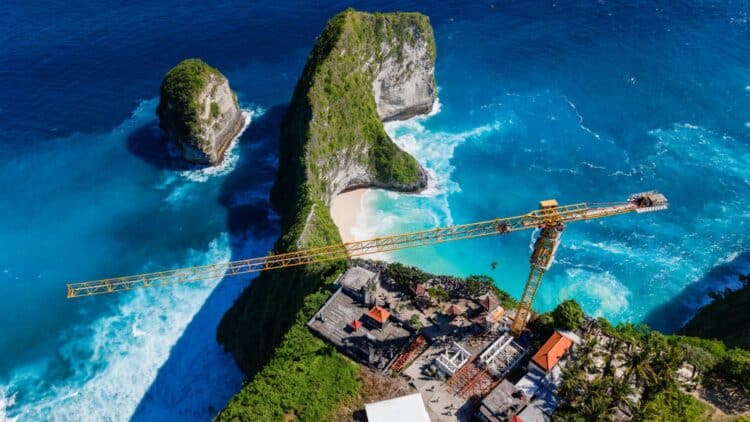It seems like everyone and their mother have been going to Bali for the holidays in recent years. With its pristine beaches and ancient culture—not to mention a very affordable economy—it has become an idyllic postcard destination where everyone continues to take photos for Instagram. It has reached a point where this international and mass tourism has finally exploded.
It all happened with the construction of a 182-meter-high glass elevator on the cliff at Kelingking Beach on the island of Nusa Penida. You’ve probably heard of it; it’s a very famous bay because one of its breakwaters is naturally shaped like a T-Rex with its mouth open. The elevator was going to provide views for all the tourists, as well as injecting money into the community. But where is the line between mass tourism and the natural conservation of landscapes?
Kelingking Beach and the controversial elevator
The censor project has been officially suspended, and not because of a lack of building permits. Right now, Balinese society is up in arms against unbridled tourism. The local economy’s dependence on international tourism is wearing thin the patience of a population that, until two generations ago, was engaged in agriculture and fishing.
Kelingking Beach, located in Nusa Penida, is one of the most famous cliffs in the world. Its limestone cliff against the crystal clear waters attracts millions of photographers and travelers annually. Much of its beauty is due to the rugged terrain: accessing the lower beach is difficult and dangerous. The only way down is via precarious and steep stairs, a walk that takes about an hour. This has inevitably led to falls and injuries among travelers over the years.
To solve this access problem, the mega elevator was proposed. It was an ambitious glass and steel project, with a height of 182 m, which, together with local partners and Chinese investors, cost almost $14 million. The aim was to make the site fully accessible to everyone and also offer panoramic viewpoints from which to take photos.
The outrage was immediate: residents, activists, and environmentally conscious tourists alike expressed their disapproval. The general opinion was that it would be “a magnificent view ruined.” If tourists travel halfway around the world to find natural landscapes untouched by human hands, what does Bali gain by building a mega-structure that overwhelms the landscape?
Suspension of construction work
So the project (which was only 30% complete) had been halted and reported by the local authorities. The developers had made the mistake of failing to obtain essential work safety and disaster mitigation permits. They had also violated Indonesia’s spatial planning law (Law No. 26 of 2007).
Despite being an idyllic natural setting, the construction site is located in an area at risk of natural disasters. It is exposed to seismic risks and tsunamis. In addition, the structure fails to comply with the requirement to respect traditional Balinese architectural design. Not only did the elevator clash with the rest of the landscape, but it could also pose a danger to tourists who rode it.
The economy of Bali
Despite activist groups opposed to mass tourism, the Balinese economy is completely tied to international tourism. This dependence has created an “economic monoculture” that has displaced other industries. In fact, tourism accounts for more than 80% of the island’s gross domestic product.
And if you had the feeling that absolutely everyone you know has been to Bali at some point, you weren’t imagining things. In its pre-pandemic record year (2019), Bali received more than 6.2 million foreign visitors. After COVID, the figures recovered to 6 million in 2024. These visitors leave a lot of money in this Southeast Asian economy.
On average, each foreign tourist spends US$1,700 per stay. Before the pandemic, it was estimated that total revenue from international tourism amounted to US$7.5 billion per year.

